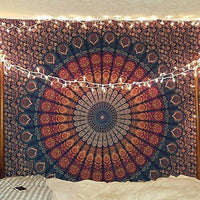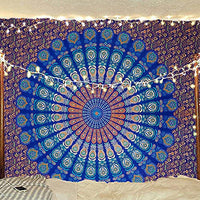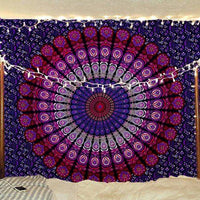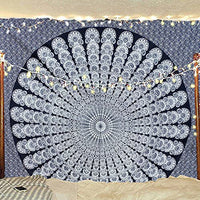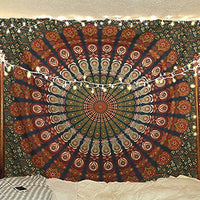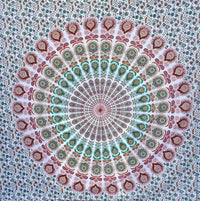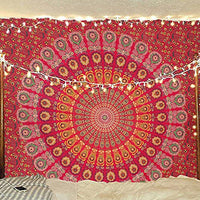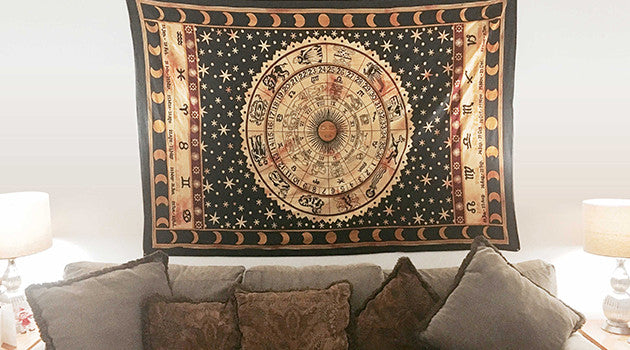The Main Principles of Interior Design
You don’t have to be an interior designer in order to gain knowledge about the main principles of Interior Design. In fact any layman can learn about these and use them while designing or decorating their homes. Since it is you who is going to live in the house it makes sense for you to decorate your home the way you want.
Let us now go on to learn about these principles of interior design, one by one…
Harmony and Unity
The first thing you need to determine before planning your home or deciding on its interiors, is the theme, style or mood that you wish to create. It is important to think of the entire home in totality. It should be considered as a series of spaces that are linked together by stairways and halls. There should be common theme or style and it should run through your entire home.
While selecting a theme, it is not necessary to include the same interior design elements in all the rooms of your house. However, they should complement each other and work together so as to strengthen the entire composition. They have to be coordinated in some way or the other to express or enhance that theme, style or mood.
One way to do this is through the use of colors. In fact, you should pick a color scheme that brings about some harmony and unity in your spaces. A color scheme will generally consist of three or four colors that complement each other. You can work on different shades of these colors to decorate your home.
Here is a little about the eight basic color schemes you can choose from:

Complementary color scheme: These are the colors that are opposite to each other on the color wheel. For Example,
- Green and Red
- Blue-Green and Red-Orange
- Blue and Orange
- Yellow and Violet
While using complementary color schemes you may have to vary the shades as well as the saturation levels.
Split Complementary Color Scheme: There are mainly three colors in this color scheme – the main color and two more colors that are at the either side of the complementary color. For example,
- Red, Blue-Green and Yellow-Green
- Yellow, Red-Violet and Blue-Violet
- Green, Red-Orange and Red-Violet
Triad color scheme:Take any three colors that are equidistant from the color wheel and there you have your Triad Color Scheme. For Example, you could use: • Green, Orange and Violet
• Red, Blue and Yellow
• Yellow, Red Violet and Blue Violet
Monochromatic Color Scheme:To achieve this color scheme you can play around with various depths and shades of a single color. For instance, you could use: • Light Blue and Dark Blue
• Light Green, Grass Green and Dark Green
• Lavender and Purple
Analogous color scheme:If you take one main color and choose a few colors that you find on the either sides of it on the color wheel, you have an analogous color scheme. For instance, you could have: • Green, Yellow-Green and Blue-Green
• Yellow, Green and Yellow-Green
• Yellow, Yellow-Orange and Yellow-Green
Neutral color scheme:In this color scheme you just choose any color on the color wheel and then reduce it by adding some black to it.
Achromatic color scheme:This is a color scheme that you create with just whites, blacks and greys.
Secondary color scheme:You get a secondary color scheme when you use colors like Orange, Purple and Green together.
If you want to create a well-designed space, you will have to unify the various principles and elements of deign. By focusing on unity you will be creating a sense of order in your home. You will have to maintain consistency with respect to color, pattern, shapes and sizes. In the meanwhile you can repeat elements and balance them across the room. You could even add a bit of a variety here and there so you’re your room develops a personality of its own. Focus on everything right from the light switches and the cupboard handles to the color of the piping on your cushion and trimmings on your lamp shade. Everything should be right and should enhance the overall feel of your room.
Balance
This principle refers to a systematic distribution of elements so as to achieve a visual equilibrium. You have to create a central point or axis, which could be real or imaginary, and then distribute the visual weight of the elements evenly around it.
You can choose one of the three ways to achieve balance in interiors:
Symmetrical Balance:You get a secondary color scheme when you use colors like Orange, Purple and Green together.
If you want to create a well-designed space, you will have to unify the various principles and elements of deign. By focusing on unity you will be creating a sense of order in your home. You will have to maintain consistency with respect to color, pattern, shapes and sizes. In the meanwhile you can repeat elements and balance them across the room. You could even add a bit of a variety here and there so you’re your room develops a personality of its own. Focus on everything right from the light switches and the cupboard handles to the color of the piping on your cushion and trimmings on your lamp shade. Everything should be right and should enhance the overall feel of your room.

Asymmetrical Balance:This is a better way to create a natural looking space that is very lively. Here, the number of elements that you use may not really matter; but they should be of equal visual weight.There is no duplication in this type of balance; yet you will be required to balance the different lines, forms, colors or textures that you use. For instance, you could place a side table and a table lamp on one end of your sofa and then use a floor lamp at the other end. Creating this kind of balance can be quite challenging; yet, it does create a visually exciting room powered by a dynamic design.
Radial balance:In this type of balance, you create a focal point and then let all other elements radiate from that point, arranging themselves in circular symmetry.For instance, a dining table could be your focal point and you can arrange similar chairs around it. In the next round you could use a painting, a sculpture and maybe even a tapestry.
Rhythm
By using Rhythm in your space you can create an organized movement of the eye across the various elements of your room. This can help in maintaining a visual tempo between various elements that have different visual weights.
Rhythm is based on five main principles:

Repetition: This is all about using similar lines, forms, shapes, colors, patterns or textures throughout your interior. This delivers a sense of cohesiveness and stability. For instance if you have a hallway and you want the eye to follow a continuous movement across this hallway, you can make use of a few similar floor lights and repeat them across. If you have a staircase, you could use repeated shapes that take the eye smoothly down the steps.
Gradation: Here you are using the same objects but of different sizes, going from small to large. Similarly you can also use a color, going from light to dark. By creating such a rhythm you can let the eye go up or down the gradation level. For instance, you could use cushions of different sizes to invite someone to sit at a particular place.
Transition: If you want the eye to travel gently from one area to another, in an uninterrupted, continuous manner, you can create rhythm through transition. For instance, if you have a bay window that immediately captures the eye of the visitor, you could put up a curved sofa alongside the window to lead the eye towards that space.
Contrast: Contrast is another principle of rhythm that helps the eye to travel from one element to another. You can use contrasting colors to make this possible. You can also create contrast using styles. For instance, you can hang a row of paintings or tapestries across your wall to create a rhythmical contrast that is interesting.
Radiation: You can create this kind of rhythm by creating a focal point and balancing or repeating your design elements around it. For instance, if you put up a circular table, you could keep some chairs and maybe a vase on it to make them radiate off the table. You can then add additional visual stability by putting up wall paintings or wall tapestries.
Emphasis
Emphasis is all about creating and highlighting a focal point in your space. You can decide on a particular piece of furniture or art to be the central point of your space and then emphasize it through various other elements. Tapestries can make very good focal points as they are available in different sizes, colors, textures and designs. You can choose a well-designed colorful tapestry and put it up on one of the walls. If it is a hallway make sure you put it right on the wall that is at the end of the hallway.
You can put up a spot light or use a bright color to paint that wall. All the other elements that you use in this space should only complement the tapestry, without craving for attention. The tapestry or the focal point should get the top-most priority.

Here are a few tips that you could use while creating a focal point in your room:
• Make sure you arrange your furniture in such a way that it directs the eye to the focal point you have created in the room.
• Once you have created a focal point, if you find a corner or a wall that looks absolutely empty, you could use it for your secondary focal point. You could put up a side table with a lamp or a plant or you could even create a small desk or a reading area.
• For large spaces, you may need more focal points. You could break your room into different sections or seating areas and create one or two focal points in each of these areas.
Contrast
Contrast is something that differentiates one thing from the other. We generally create contrast throughcolor, texture or even shape. You can put up a few pillows of contrasting colors such as white and black to distinguish a particular object. You may even use different shapes such as a rectangular sofa and a circular mirror so that both the objects get attention. You could even divide your space into positive and negative, according to usability.

Contrasting pieces tend to fight for attention without being too over-powering. It is this conflict between objects that makes things interesting. This principle can be extremely useful when creating a focal point. For instance, if you want to put up a tapestry and would want it to stand out, make sure you choose one, the color of which contrasts the wall. Or if your square/rectangular dining tableis the focal point, you could put up a circular light fixture on top of it to create a contrast.
Scale and Proportion
Scale and proportion are things you have to focus on, while decorating your space. For instance, if your space has a high ceiling, it won’t look good if you choose low rise furniture such as ottomans. Your furniture will also need to be high-rise. If you have a big sofa you cannot use pillows that are under-stuffed as this will under-accessorize your sofa, making it look empty. In case you have a huge wall, putting up a small painting may not do justice. Instead, you could choose a tapestry of the right size.
Every item that you use needs to be measured and scaled according to your space. While scale is the size of things you use, the proportion is something that creates a relationship between them.
Details
When it comes to decorating your home, every detail matters. Whether it is that tiny embroidery pattern on your pillow cover or the lace that trims your lampshade, everything has something to add to your overall interior design, in its own way.
Once you are done with achieving all the above principles of interior design, it is time to beautify your space by paying attention to details.
Now that you understand what is to be done and how it is to be done, go ahead and start decorating your place, the way you wish. These principles should help you achieve the perfect balance and harmony.
Happy tapestry shopping!
Thanks & regards
Dr. Hitesh Sharma
Director
Bless International (™)
https://blessestore.com
